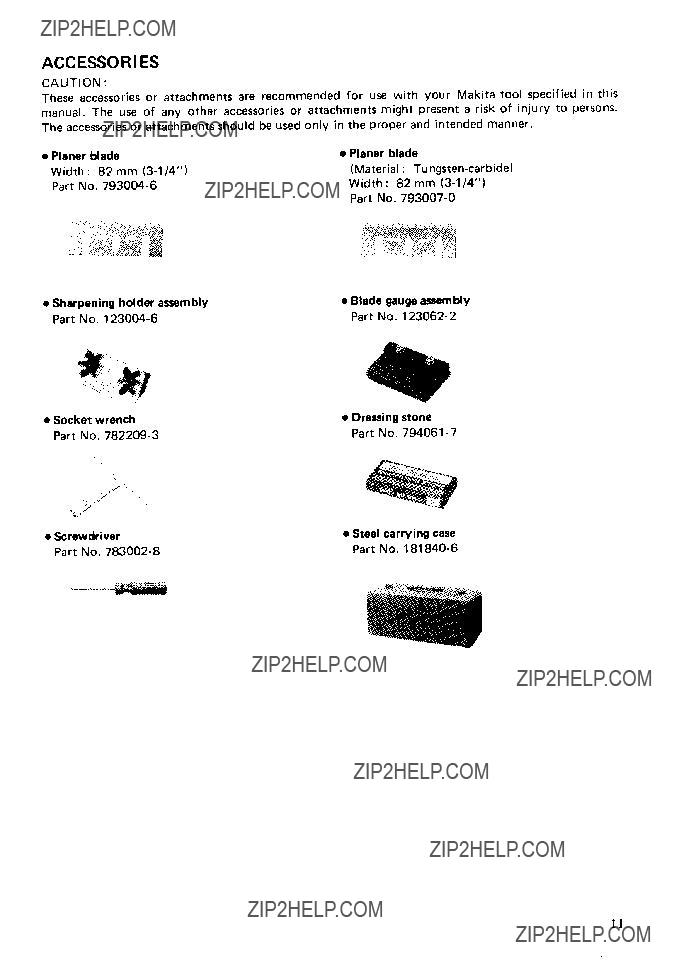
Curved Planer
82 mm
INSTRUCTION MANUAL

Curved Planer
82 mm
INSTRUCTION MANUAL

IMPORTANT SAFETY INSTRUCTIONS
WARNING: When using electric tools, basic safety precautions should always be followed to reduce the risk of fire, electric shock, and personal injury, includ- ing the following:
READ ALL INSTRUCTIONS.
1. KEEP WORK AREA CLEAN. Cluttered areas and benches invite injuries.
2.CONSIDER WORK AREA ENVIRONMENT. Don't use power tools in damp or wet locations. Keep work area well lit. Don't expose power tools to rain. Don't use tool in presence of flammable liquids or gases.
3.KEEP CHILDREN AWAY. All visitors should be kept away from work area. Don't let visitors ccntact tool or extension cord.
4.STORE IDLE TOOLS. When not in use, tools should be stored in dry, and high or
5.DON'T FORCETOOL. It will do the job better and safer at the rate for which it was intended.
6.USE RIGHT TOOL. Don't force small tool or attachment to do the job of a
7.DRESS PROPERLY. Don't wear loose clothing or jewelry. They can be caught in moving parts. Rubber gloves and
8.USE SAFETY GLASSES. Also use face or dust mask if cutting operation is dusty.
9.DON'T ABUSE CORD. Never carry tool by cord or yank it to disconnect from receptacle. Keep cord from heat, oil, and sharp edges.
IO. SECURE WORK. Use clamps or a vise to hold work. It's safer than using your hand and it frees both hands to operate tool.
11. DON'T OVERREACH. Keep proper footing and balance at all times.
12.MAINTAIN TOOLS WITH CARE. Keep tools sharp and clean for better and safer performance. Follow instructions for lubricating and changing acces- sories. Inspect tool cords periodically and if damaged, have repaired by autho- rized service facility. Inspect extension cords periodically and replace if damaged. Keep handles dry, clean, and free from oil and grease.
13.DISCONNECT TOOLS. When not in use, before servicing, and when chang- ing accessories, such as blades, bits, cutters.
14.REMOVE ADJUSTING KEYS AND WRENCHES. Form habit of checking to see that keys and adjusting wrenches are removed from tool before turning it on.
15.AVOID UNINTENTIONALSTARTING. Don't carry
16.OUTDOOR USE EXTENSION CORDS. When tool is used outdoors, use only extension cords intended for use outdoors and so marked.
L

17.STAY ALERT. Watch what you are doing, use common sense. Don???t operate tool when you are tired.
18.CHECK DAMAGED PARTS. Before further use of the tool, a guard or other part that is damaged should be carefully checked to determine that it will operate properly and perform its intended function. Check for alignment of moving parts, binding of moving parts, breakage of parts, mounting, and any other conditions that may affect its operation. A guard or other part that is damaged should be properly repaired or replaced by an authorized serv- ice center unless otherwise indicated elsewhere in this instruction manual. Have defective switches replaced by authorized service center. Don???t use tool if switch does not turn it on and off.
19.GUARD AGAINST ELECTRIC SHOCK. Prevent body contact with grounded surfaces. For example; pipes, radiators, ranges, refrigerator enclosures.
20.PROPER GROUNDING. This tool should be grounded while in use to protect the operator from electric shock.
21.EXTENSION CORDS: Use only
VOLTAGE WARNING: Before connecting the tool to a power source (receptacle, outlet, etc.) be sure the voltage supplied is the same as that specified on the nameplate of the tool. A power source with voltage greater than that specified for the tool can result in SERIOUS INJURY to the user - as well as damage to the tool. If in doubt, DO NOT PLUG IN THE TOOL. Using a power source with voltage less than the nameplate rating is harmful to the motor.
3

ADDITIONAL SAFETY RULES
1.Rags, cloth, cord, string and the like should never be left around the work area.
2.Avoid cutting nails. Inspect for and remove all nails from the workpiece be- fore operation.
3.Handle the blades very carefully.
4. Be sure the blade installation bolts are securely tightened before operation. 5.Hold the tool firmly with both hands.
6. Keep hands away from rotating parts.
7. Before using the tool on an actual workpiece, let it run for a while. Watch for vibration or wobbling that could indicate poor installation or a poorly balanced blade.
8. Make sure the blade is not contacting the workpiece before the switch is turned on.
9. Wait until the blade attains full speed before cutting.
IO. Keep at least 200 mm (8") away from the tool at all times.
11 . Always switch off and wait for the blades to come to a complete stop be- fore any adjusting.
12.Never stick your finger into the chip chute. Chute may jam when cutting damp wood. Clean out chips with a stick.
13.Do not leave the tool running. Operate the tool only when
14.When leaving the planer, switch off and set it with the front base up on a wooden block, so that the blades do not contact anything.
15.Always change both blades or covers on the drum, otherwise the resulting imbalance will cause vibration and shorten tool life.
SAVE THESE INSTRUCTIONS.
4

Removingor installingplaner blades
WARNING :
Always be sure that the tool is switched off and unplugged before removing or installing the blades.
To remove the blades on the drum, un- screw the three installation bolts with the socket wrench. The drum cover comes off together with the blades.
Place the blade on the gauge base so that the blade edge is perfectly flush with the inside edge of the gauge plate. Place the adjusting plate on the blade, then simply press in the heel of the adjustingplate flush with the back side of the gauge base and
tighten the two screws on the adjusting plate. Now slip the heel of the adjusting plate into the drum groove, then fit the drum cover on it. Tighten the three in- stallation bolts evenly and alternately with the socket wrench.
WARNING:
Tighten the blade installation bolts carefully when attaching the blades to the tool. A loose installation bolt can be dangerous. Always check to see they are tightened securely.
5

Adjustingdepth of cut
Depth of cut may be adjusted by simply turning the knob on the front of the tool.
Adjusting front base
1.To create a curved surface, loosen the wing nut. For a concave planing job, raise the front base; for a convex plan- ing job, lower the front base. In either case, the front base must be aligned with the cutting line. Then tighten the wing nut securely.
NOTE:
As explained later, although the objec- tive is to cut until the cutting line is eventually reached, the planing must take place gradually.
6

2.To create a flat surface, loosenthe wing I nut after setting the tool on a level sur- face. Turn the front knob on the tool until the front base is perfectly level with the rear base. Then tighten the wing nut securely.
Switch action
To start the tool, simply pull the trigger. Release the trigger to stop. For continuous operation, pull the trigger and then push in the lock button. To stop the tool from the locked position, pull the trigger fully, then release it.
WARNING:
Before plugging in the tool, always check to see that and returns to the "OFF" position when released.
Planingoperation
First, rest the tool front base flat upon the workpiece surface without the blades mak- ing any contact. Switch on and wait until the blades attain full speed. Then move the tool gently forward. Apply pressureon the front of tool a t the start of planing, and a t the back a t the end of planing. The speed and depth of cut determine the kind of finish. The power planer keeps cutting a t a speed that will not result in jamming by chips. For rough cutting, the depth of cut can be increased, while for a good finish you should reduce the depth of cut and advance the tool more slowly.
FWing n u t
the trigger switch actuates properly
7

*When beginning the planing of a flat
workpiece to obtain eventually a concave shape, first take down the middle of the
workpiece, gradually planing until the ultimate concave shape is achieved.
Shiplappingor corner cuts (flush cuts)
When performing the shiplappingor corner cuts (flush cuts up against a wall), remove the wing bolt to take off the drum cover,
NOTE:
Corner cuts (flush cuts up against a wall) are impossible, of course, if the tool cannot be moved forward or backward because of a wall or something blocking the tool path.
First take down both ends of the workpiece
First take down the middle of the workpiece
WARNING:
 With the drum cover removed for corner cuts (flush cuts) or shiplapping, be very careful not to touch the drum/blades or allow your clothing to be caught during operation.
With the drum cover removed for corner cuts (flush cuts) or shiplapping, be very careful not to touch the drum/blades or allow your clothing to be caught during operation.
 After performing the shiplapping or corner cuts (flush cuts), ALWAYS
After performing the shiplapping or corner cuts (flush cuts), ALWAYS
8

Sharpeningplaner blades
Always keep your bladessharp for the best I
performance possible. Use the sharpening holder to remove nicks and produce a fine
edge.
First, loosen the two wing nuts on the holder and insert the blades (A) and (B), so that they contact the sides (C) and (D). Then tighten the wing nuts.
Immerse the dressing stone in water for 2 or 3 minutes before sharpening.' Hold the holder so that the blades both contact the dressing stone for simultaneous sharpening a t the same angle.
9

MAINTENANCE
CAUTION:
Always be sure that the tool is switched off and unplugged before attempting to perform inspectionor maintenance.
To maintain product SAFETY and RELIABILITY, repairs, any other maintenance or adjustment should be performed by Makita Authorized or Factory Service Centers, always using Makita replacement parts.
10

ACCESSORIES
CAUTION:
These accessories or attachments are recommended for use with your Makita tool specified in this manual. The use of any other accessories or attachments might present a risk of injury to persons. The accessories or attachments should be used only in the proper and intended manner.
11

Jan
82 mm
CURVED PLANER
Model 1001
Note The switch, noise suppressor and other part configuratlons may differ from country to country
12

Note The switch noise suppressor and other part spechcations may differ from country 10 country
13

14


Makita Corporation
Anjo, Aichi 446 Japan